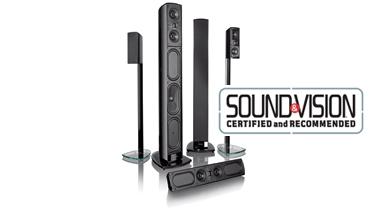Definitive Technology Mythos STS SuperTower home theater speaker system

| The Short Form |
| $4,616 (as tested, with Gem stands) / DEFINITIVETECH.COM / 410-363-7148 |
| Snapshot |
| A dynamic-sounding music and movie system that delivers a satisfying dose of bass in a sleek, compact package |
| Plus |
| • Compact, attractive design • Built-in sub allows for full-range sound from STS tower • Excellent coverage from Gem surrounds |
| Minus |
| • Tower positioning can be tricky |
| Key Features |
| • Mythos STS SuperTower ($1,500 each): 1-in aluminum-dome tweeter, two 4½-in midrange drivers, 5 x 10-in woofer, two 5 x 10-in passive radiators; 300-watt Class D amp; 47½ x 5½ x 8½ in, 54 lb •Mythos Nine ($799): 1-in aluminum-dome tweeter, two 4½-in midrange drivers, two 4½ x 8-in woofers; 28 x 5½ x 4 in, 13 lb • Mythos Gem ($279 each; stands: $259 a pair): 1-in aluminum-dome tweeter, two 3½-in midrange/woofers; 10¼ x 4¼ x 4 in, 4½ lb |
While it might not rank as high on the innovation scale as its predecessors, the Mythos STS follows a similar trajectory by providing a sensible next step for the line. Def Tech has shrunk the ST's cabinet down to a 471?2-inch height, and is offering the new speaker at a more affordable $3,000-a-pair price. To round out my test system, the company bundled the STS L/R pair with its brand-new Mythos Nine for a center channel and a pair of Mythos Gems for surrounds. Total cost for this package comes to $4,357 ($4,616 with Gem speaker stands), a very fair price when you consider that you get a pair of powered subwoofers thrown in free when you buy STS SuperTowers.
The STS's black aluminum cabinet has a svelte, stealthy look - with the lights dimmed, they really disappeared in our home theater/test facility. And I found its scale friendlier than the company's more imposing ST model, which tops out at 511?2 inches. The base is particularly elegant. Its compact footprint and beveled edges make for a seamless visual blend with the speaker, while the dark granite material offers sturdy support.
Def Tech coaxes big bass out of its slim tower by using a narrow 5 x 10-inch "racetrack" subwoofer driver coupled to a set of same-size passive radiators. (The radiators act like ports to reinforce low-end output.) The STS's top section, meanwhile, contains a pair of 41?2-inch midrange drivers flanking a 1-inch aluminum-dome tweeter coated with a ceramic material to inhibit treble edginess.
The Mythos Nine is a flexible on-wall speaker that can be positioned either vertically for front left/right and surround channels or horizontally for a center-channel configuration. The Nine's angled end caps and black aluminum cabinet echo the STS's design. Def Tech includes both a bracket for wall mounting and a leveling foot for on-shelf installations.
The compact Gem is another multipurpose Mythos designed to serve either as a front or surround speaker. It has the same cabinet design as the rest of the system, and can be either wall mounted or placed on top of Def Tech's matching stand ($259 a pair). The Gem's 31?2-inch bass/midrange drivers are angled in opposite directions to better disperse the sound and widen the sonic image.
SETUP
Setting up the towers took longer than usual, mostly because the STS holds both the speaker and sub - so, unlike with a conventional sub/sat system, you can't tweak the sub position for best bass without dragging the rest of the speaker along with it. When placed about 4 to 5 feet out into the room, the STS cast a surprisingly big soundstage. But its low end also sounded lumpy and a bit limited at that position. Nudging the speakers back another 2 feet toward the front wall helped a great deal to reinforce the bass and smooth out its response in our room.
You get two hookup options with the STS. The first is to run it full-range by way of a standard speaker connection from a receiver or amp. The second is to split your receiver's LFE output with a Y adapter and run separate interconnects to each speaker's RCA-jack LFE input. While the first method simplifies things, the second gives you bass-level control by way of a volume dial on the speaker's back panel. Since I was using a separate LFE connection for the STS subs, I selected both Large for the front speakers and Yes for the subwoofer in my receiver's speaker setup menu. (When a speaker-level connection is made to the STS without an LFE connection, those same options should be set to Large for the front speakers and No for subwoofer.)
Compared with positioning the STS towers, getting the Nine center and the Gem surrounds up and running was no problem. The Nine sat on a shelf directly below our plasma TV's 50-inch screen and angled slightly toward the listening position. The Gems, meanwhile, sat on a pair of high speaker stands to the side of and slightly behind the couch.
- Log in or register to post comments












































